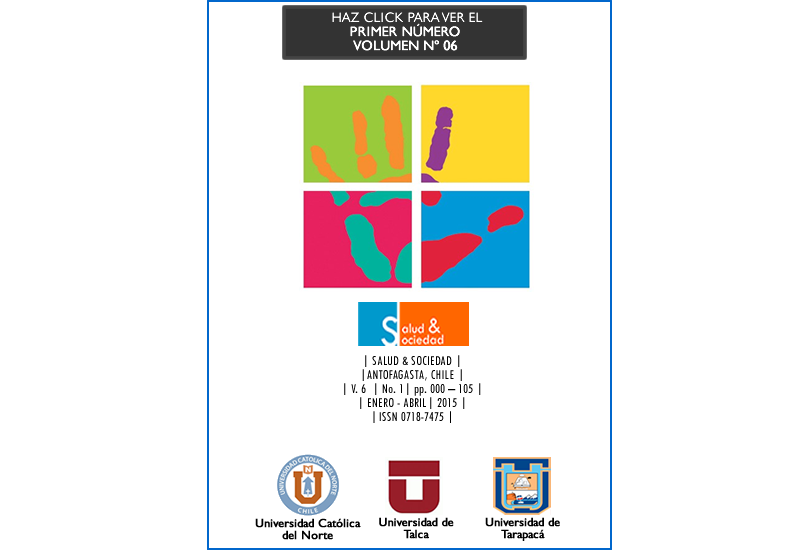Propiedades psicométricas de la escala de experiencias en relaciones cercanas-estructuras de relaciones (ECR-RS) para medir apego en adolescentes chilenos
DOI:
https://doi.org/10.22199/S07187475.2015.0001.00005Palavras-chave:
Apego, adolescencia, propiedades psicométricas ECR-RS, Attachment, adolescence, ECR-RS psychometric properties,Resumo
Objetivo: evaluar las propiedades psicométricas de la Escala de Experiencias en Relaciones Cercanas - Estructuras de Relaciones (ECR-RS) en adolescentes chilenos entre 12 y 17 años de edad. Método: se evaluaron dos muestras independientes (N=108; N=504) con la Escala de autoreporte ECR-RS, que mide el apego en sus dos dimensiones: ansiedad ante el abandono y evitación de la intimidad. Resultados: respecto de la validez de criterio, los resultados fueron distintos a lo esperado en relación con la dimensión de ansiedad ante el abandono. Si bien la dimensión de evitación de la intimidad se asoció con los constructos teóricamente propuestos en las direcciones esperadas (depresión y ansiedad), la dimensión de ansiedad no se asoció con ninguna de estas variables. Conclusiones: El ECR-RS presentó valores de confiabilidad adecuados y la estructura bidimensional propuesta originalmente fue replicada. Los hallazgos son discutidos en función de posibles explicaciones y líneas de investigación futura.
Objective: To evaluate the psychometric properties of the Experiences in Close Relationships Revised (ECR-RS) Scale in Chilean adolescents between 12 and 17 years old. Method: Two independent samples (N=108; N=504) were evaluated with the self-report scale ECR-RS which measures attachment in two dimensions: anxiety over abandonment and avoidance of intimacy. Results: Regarding the criterion validity, the dimension anxiety over abandonment did not show any relationship with the variables depression and anxiety, which was unusual. On the contrary, the dimension avoidance of intimacy did show a relationship with the theory as expected. Conclusions: ERC-RS showed appropriate confiability values and the proposed bidimensional structure was replicated. These findings are discussed for possible explanations and future research lines.
Referências
Ainsworth, M., & Bowlby, J. (1991). An ethological approach to personality development. American Psychologist,46(4), 333–341. doi: 10.1037/0003-066X.46.4.333
Allen, J. (2008). The attachment system in adolescence. J. Cassidy & P. R. Shaver (Eds.), Handbook of attachment. Theory, research and clinical applications .Nueva York: The Guildford Press.
Bartholomew, K., & Horowitz, L. (1991). Attachment styles among young adults: a test of a four–category model. Journal of Personality and Social Psychology, 61, 226–244. doi: 10.1037/0022-3514.61.2.226
Bartle - Haring, S. (1997). The relationships among parent- adolescent differentiation, sex role orientiation and identity development in late adolescence and early adulthood. Journal of Adolescence, 20, 553-565. doi: 10.1006/jado.1997.0109
Bentler. P. M. (2005). EQS 6 structural equations program manual. Encino, CA: Multivariate Software (www.mvsoft.com).
Blatt, S. J. & Levy, K. N. (2003). Attachment Theory, Psychoanalysis, personality development, and psychopathology. Psychoanalytic Inquiry. 23, 102-150. doi: 10.1080/07351692309349028
Bowlby, J. (1980). La Pérdida Afectiva. Buenos Aires: Paidós.
Bowlby, J. (1986). Vínculos Afectivos: Formación, desarrollo y pérdida. Madrid: Morata.
Brando, M., Valera, J., Y Zarate, Y. (2008). Estilos de apego y agresividad en adolescentes. Segunda Época, 27(1), 16-42.
Brennan, K., Clark, C., & Shaver, P. (1998). Self-report measurement of adult attachment: An integrative overview. In J. A. Simpson & W. S. Rholes (Eds.), Attachment Theory and close relationships (pp.46–76). New York: Guilford Press.
Brenning, K., Soenens, B., Braet, C., & Bosmans, G. (2011). An adaptation of the Experiences in Close Relationships ScaleRevised for use with children and adolescents. Journal of Social and Personal Relationship, 28(8), 1048–1072. doi: 10.1177/026540751140241
Cassidy, J. (2008). The nature of the child’s ties. In J. Cassidy & P. R. Shaver (Eds.), Handbook of Attachment Theory, research and clinical applications. Nueva York: The Guildford Press.
Cooper, M. L., Shaver, P. R., & Collins, N. L. (1998). Attachment styles, emotion regulation, and adjustment in adolescence. Journal of Personality and Social Psychology, 74(5), 1380– 1397.
DeKlyen, M., & Greenberg, M. (2008). Attachment and psychopathology in childhood. In J. Cassidy y P. R. Shaver (Eds.), Handbook of Attachment. Theory, research and clinical applications (pp. 637-665). New York: The Guildford Press.
Delgado, I., Oliva, A., & Sánchez-Queija, I. (2011). Apego a los iguales durante la adolescencia y la adultez emergente. Anales de Psicología, 27, 155-163. doi: 10.6018/27.1.113581
Donbaeka, F. D., & Elklitb, A. (2013). A validation of the Experiences in Close Relationships-Relationship Structures scale (ECR-RS) in adolescents. Attachment & Human Development. doi: 10.1080/14616734.2013.850103
Escobar, M., & Santelices, P. (2013). Attachment in adopted adolescents. National adoption in Chile. Childrens and Youth Service Review, 35, 488-492.
Fraley, C., Waller, G., & Brennan, A. (2000). An item-response theory analysis of self-report measures of adult attachment. Journal of Personality and Social Psychology, 78, 350-365.
Fraley, C., Heffernan, M., Vicary, A., & Brumbaugh, C. (2011). The experience in close relationships-relationship structures questionnaire: A method for assessing attachment orientations across relationships. Psychological Assessment, 23(3), 615-125. doi: 10.1037/a0022898
Galán, A. (2010). El apego. Más allá de un concepto inspirador. Revista de la Asociación Española de Neuropsiquiatría, 30(108), 581-595.
Garrido-Rojas, L. (2006). Apego, emoción y regulación emocional. Implicaciones para la salud. Revista Latinoamericana de Psicología, 38(3), 493-507.
George, C., Kaplan, N., & Main, M. (1985). Adult Attachment Interview. Unpublished manuscript, University of Berkeley, California.
Gempp, R., Avendaño, C. Y Muñoz, K. (2004) Normas y punto de corte para la Escala de Depresión del centro para estudios epidemiológicos (CES-D) en población juvenil chilena. Terapia Psicológica, 22(2), 145-156.
González, L. Y Méndez, L. (2006). Relación entre autoestima, depresión y apego en adolescentes urbanos de la comuna de Concepción, Chile. Terapia Psicológica, 24(1), 5-14.
Harel, O., Zimmerman, R., & Dekhtyar, O. (2008). Approaches to the handling of missing data in communication research. En A. F. Hayes, M. D. Slater & L. B. Snyder (Ed.),. Advanced data analysis methods for communication research (pp. 349-371). Thousand Oaks: Sage Publications.
Hazan, C. & Shaver, P. (1987). Romantic love conceptualized as an attachment process. Journal of Personality and Social Psychology, 52, 511-524.
Kamkar, K., Doyle, A., & Markiewicz, D. (2012). Insecure Attachment to parents and depressive symptoms in early adolescence: Mediating roles of atributtions and self-esteem. International Journal of Psychological Studies, 4(2) 3-18. doi:10.5539/ijps.v4n2p3
Kline, R. B. (2005). Principles and practice of structural equation modeling (2nd Ed.). New York: Guilford Press.
Kobak, R., Sudler, N., & Gamble, W. (1991). Attachment and depressive symptoms during adolescence: a developmental pathways analysis. Development Psychopathology, 3, 461–474. doi: 10.1017/S095457940000763X
Lecannelier, F. (2002). La entrevista de apego en niños/ Child attachment interview - CAI. Terapia Psicológica, 20(1), 53-60.
Lee, A., & Hankin, B. (2009). Insecure attachment, dysfunctional attitudes, and low self-steem predicting prospective symptoms of depression and anxiety during adolescence. Journal of Clinical Child & Adolescencent Psychology, 38(2), 219-23. Doi: 10.1080/15374410802698396
Loinaz, I., Echeburúa, E. & Ullate, M. (2012). Estilo de apego, empatía y autoestima en agresores de pareja. Terapia psicológica, 30(2), 61-70.
Marcia, J. (1983). Some Directions for the investigation of ego development in Early Adolescence. The Journal of Early Adolescence, 3(3), 215-223.
Martínez, L. (2007). Mirando al Futuro: Desafíos y oportunidades para el desarrollo de los adolescentes en Chile. Pshyke. 16(1). 3-14. doi: 0.4067/S0718-22282007000100001
Martínez, C., & Santelices, M. (2005) Evaluación del apego en el adulto: Una revisión. Psykhe, 14(1), 181-191. doi: 10.4067/S0718-22282005000100014
McElhaney, K. B., Allen, J. P., Stephenson, J. C., & Hare, A. L. (2009). Attachment and autonomy during adolescence. En Lerner, R. & Steinberg, L. (Eds.), Handbook of adolescent psychology (pp. 358-403). New Jersey: John Wiley & Sons.
Mikulincer, M., & Shaver, P. R. (2007). Attachment in adulthood: Structure, dynamics, and change. New York: Guilford.
Moretti, M., & Peled, M. (2004). Adolescentparent attachment: Bonds that support healthy development. Paedriatics & Child Health, 9(8), 551-555.
Oliva, A. (2004). Estado actual de la Teoría del Apego. Revista de Psiquiatría y Psicología del Niño y del Adolescente, 4(1), 65-81.
Oliva, A. (2011). Apego en la adolescencia. Acción Psicológica, 8(2), 56-65.
Pardo, G., Sandoval, A., Y Umbarila, D. (2004). Adolescencia y depresión. Revista Colombiana de Psicología, 13, 13-28.
Pacheco, B., Y Ventura, T. (2009). Trastorno de ansiedad por separación. Revista Chilena de Pediatría, 28(2), 109-119.
Rojas-Barahona, C., Zegers, B., & Förster, C. (2009) La Escala de Autoestima de Rosenberg: Validación para Chile en una muestra de jóvenes adultos, adultos y adultos mayores. Revista Médica de Chile, 137, 791-800.
Román, M. (2011). Metodologías para la evaluación del apego infantil: De la observación de conductas a la exploración de las representaciones mentales. Acción Psicológica, 8(2), 27-38.
Schore, A. (2009). Advances in neuropsychoanalysis, Attachment Theory, and trauma research: Implications for self psychology. Psychoanalytic Inquiry, 22, 433-484.
Shmueli-Goetz, Y. (2001). Child Attachment Interview: Development and validation. Unpublished doctoral dissertation. University College London, England.
Smith- Castro, V. & Molina, M. (2011). La entrevista cognitiva: guía para su aplicación en la evaluación y mejoramiento de instrumentos de papel y lápiz. (Cuaderno Metodológico 5). San José, Costa Rica: Universidad de Costa Rica, Instituto de Investigaciones Psicológicas.
Soto, C., John, P., Gosling, S., & Potter, J. (2008). The developmental psychometrics of Big Five Self-Reports: acquiescence, factor structure, coherence, and differentiation from ages 10 to 20. Journal of Personality and Social Psychology, 94(4), 718-737. doi: 10.1037/0022-3514.94.4.718.
Spencer, R., Guzmán, M., Fresno, A., y Ramos, N. (2012). Validación chilena del Cuestionario de Evaluación del Apego Romántico Experiences in Close Relationships (ECR): análisis de la validez de criterio. Terapia psicológica, 31(3), 313-324.
Steele, H., & Steele, M. (2005). The construct of coherence as an indicator of attachment security in middle childhood: The Friends and Family Interview. En K. A. Kerns & R. A. Richardson (Eds.), Attachment in middle childhood. Nueva York: Guilford Press.
Tabachnick, B., & Fidell, L. (2007). Using multivariate statistics. Boston: Pearson/Allyn & Bacon.
Target, M., Fonagy, P., & Shmueli-Goetz, Y. (2003).Attachment representations in school-age children: The development of the Child Attachment Interview (CAI). Journal of Child Psychotherapy, 29(2), 171-186.
Van Ijzendoorn, M., & Bakermans-Kranenburg, M., (2003). Attachment disorder and disorganized attachment: Similar and different. Attachment and Human Development, 5(3), 313-320.
Vera-Villarroel, P., Celis-Atenas, K., CórdovaRubio, N., Buela-Casal, G., & Spielberger, Ch.D. (2007). Preliminary analysis and normative data of the State-Trait Anxiety Inventory (STAI) in adolescent and adults of Santiago, Chile. Terapia Psicológica, 25,155-162.
West, M., Rose, M., Spreng, S., Sheldon–Keller, A., & Adam, K. (1998). Adolescent Attachment Questionnaire: a brief assessment of attachment in adolescence. Journal of Youth and Adolescence, 27, 661–673.
Wilkinson, R. (2004). The role of parental and peer attachment in the psychological health and self-esteem of adolescents. Journal of Youth and Adolescence, 33(6), 479-493.
Zegers B, Rojas-Barahona C., Föster C. (2009). Validez y confiabilidad del índice de Satisfacción Vital (LSI-A) de Neugarten, Havighrust & Tobin en una muestra de adultos y adultos mayores en Chile. Terapia Psicológica, 27(1), 15-26.
Publicado
Como Citar
Edição
Seção
Los autores continúan como propietarios de sus trabajos, y pueden volver a publicar sus artículos en otro medio sin tener que solicitar autorización, siempre y cuando indiquen que el trabajo fue publicado originariamente en Revista Salud & Sociedad (ISSNe:0718-7475).



_(1).png)





